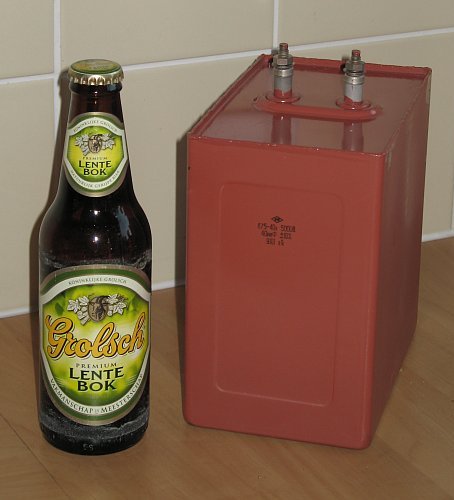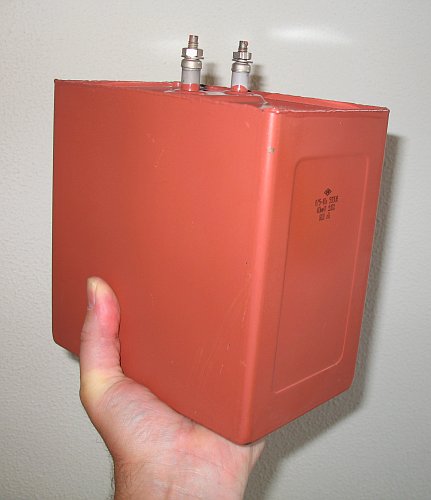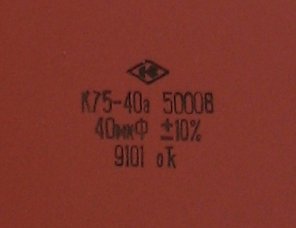woelen
Super Administrator
        
Posts: 8011
Registered: 20-8-2005
Location: Netherlands
Member Is Offline
Mood: interested
|
|
Vacuum controlled spark gap
I did an experiment as follows:
- take a 220 nF HV-capacitor and charge this to 2000 V.
- put the capacitor in an exsiccator
- attach two wires to the poles of the capacitor and keep the tips of the wires 3 to 4 mm from each other, also in the exsiccator
- close the exsiccator
- draw a vacuum in the exsiccator
At a certain point there is a flash and a nice sharp PANG in the exsiccator, the capacitor at once discharges through the gap between the tips of the
wires. The vacuum decreases the breakdown voltage.
I was thinking of using this technique for making a more powerful spark gap. I have a few 40 uF/5kV capacitors and with these I can build a really
powerful bank. Up to now, I however, did not find a suitable mechanism of discharging it, without ruining the switches, relays or whatever I use.
My idea is to use a flask, which normally is used with a buchner filter. Take a big rubber stopper as used in wine- and beermaking, make two holes in
it and let thick loudspeaker wires go through. Plug this into the flask. Inside the flask, the wires are constructed such that there is a gap of 1 cm
or so. This is connected in series with a coil, which in turn is in series with the capacitor bank. By drawing a vacuum I could ignite the coil. This
method has the great advantage that NO electrical coupling at all exists between the triggering system and the HV-capacitor bank.
Do you think it is safe to make such a vacuum controlled spark-gap, or would the spark be so violent, that it blows up the flask and glass will be
shattered around?
|
|
|
12AX7
Post Harlot
    
Posts: 4803
Registered: 8-3-2005
Location: oscillating
Member Is Offline
Mood: informative
|
|
Indeed, a good example of voltage standoff vs. pressure. Things get even more interesting at still lower pressures, where glow discharges (with a
high voltage drop, compared to an arc's low voltage) take on a ghostly appearance.
50uF 5kV Maxwell capacitors, by any chance? Those things will completely explode just the wire you suggest! Even the toughest Monster(R) Cable I
think would have some trouble with that...
Conductivity goes up with pressure. Needless to say, switching tens of kiloamperes needs a good path. The traditional quarter shrinker "switch" is
an air gap ignitron made from two brass knobs and an initiator spark (or a radioactive or UV source could also preionize the gap just as well).
Tim
[Edited on 7-20-2008 by 12AX7]
|
|
|
chromium
Hazard to Others
  
Posts: 284
Registered: 27-6-2005
Member Is Offline
Mood: reactive
|
|
220nF and 2000V is aproximately 0.5J but 5KV 40uF contains aproximately 500 joules when fully charged. All this electrical energy turns to heat and
radiation during millisecond or so. 500 joules is as much energy as 5Kg falling from 10 meters. This amount of energy could heat 1m3 of air at normal
pressure and temperature to more than 300C. So i suspect that something quite mad wil happen. If you want to experiment with this do it step by step
increasing gradually amount of stored energy and stoping before things go too dangerous.
When all think alike, then no one is thinking. - Walter Lippmann
|
|
|
Twospoons
International Hazard
    
Posts: 1322
Registered: 26-7-2004
Location: Middle Earth
Member Is Offline
Mood: A trace of hope...
|
|
Look up "Paschen's Law" which will give you breakdown voltage vs pressure. If you set up your gap to trip at a very low pressure, you shouldn't have
flasks blowing up. This kind of discharge is exactly what happens in Xenon flashlamps - some of the more powerful can easily handle 500J discharges.
The alternative is to try and find a cheap thyratron (good luck).
Helicopter: "helico" -> spiral, "pter" -> with wings
|
|
|
Nick F
Hazard to Others
  
Posts: 439
Registered: 7-9-2002
Member Is Offline
Mood: No Mood
|
|
I have a Nd:YAG laser head in which the flashlamp has an arc length of 35mm (apparently, I haven't opened mine up), inside diameter 3mm, 1mm wall
thickness. Now, although this unit is only supposed to be operated at 15 J input energy, I have heard of people putting 360 J into identical
laser heads (@ 800 V), and the explosion energy has been calculated at around 600 J.
Obviously 800 V is much lower than you were talking about, and flashlamps are designed to convert as much as possible of the input energy into light,
but this still shows that even small volumes can be used to switch quite a lot of energy.
|
|
|
woelen
Super Administrator
        
Posts: 8011
Registered: 20-8-2005
Location: Netherlands
Member Is Offline
Mood: interested
|
|
Do you really think that all energy goes into the spark inside the flask. I want the energy to go into the coil, firing things, or into a dash of
steel wool. I would expect that only a few percents of power go into the flask and the rest into the load.
If I am wrong, can someone explain to me why?
|
|
|
chromium
Hazard to Others
  
Posts: 284
Registered: 27-6-2005
Member Is Offline
Mood: reactive
|
|
| Quote: | Originally posted by woelen
Do you really think that all energy goes into the spark inside the flask. I want the energy to go into the coil, firing things, or into a dash of
steel wool. I would expect that only a few percents of power go into the flask and the rest into the load.
If I am wrong, can someone explain to me why? |
I do not think that all energy goes into the spark but somewhere it has to go. If resistance of sparc is not much less than that of the coil then
sparc will get lot of energy and even if all energy from capacitor is transfered to the magnetic field of the coil, it will be somehow released at
once when current interrupts. Coil could even initiate new spark and shoot its energy back to the capacitor but then your flask gets new load again.
Maybe someone can estimate what exactly happens but i think some cautious testing will be useful here.
[Edited on 21-7-2008 by chromium]
When all think alike, then no one is thinking. - Walter Lippmann
|
|
|
12AX7
Post Harlot
    
Posts: 4803
Registered: 8-3-2005
Location: oscillating
Member Is Offline
Mood: informative
|
|
A good estimate is 20-30V drop across an arc under atmospheric pressure. Out of 5kV, that's a bit less than 1%, so it shouldn't be too bad.
Chromium: presumably, energy goes back and forth between the capacitor and coil, several times depending on Q of the system (which is probably quite
low). The arc takes microseconds to miliseconds to deionize, much longer than the whole electrical event.
Tim
|
|
|
Maya
Hazard to Others
  
Posts: 263
Registered: 3-10-2006
Location: Mercury
Member Is Offline
Mood: molten
|
|
<<< 50uF 5kV Maxwell capacitors >>>
I've got 3X 5uF 50kV national scandia labs caps that I'm scared to charge up to full capacity for obvious reasons......
\"Prefiero ser yo extranjero en otras patrias, a serlo en la mia\"
|
|
|
Nick F
Hazard to Others
  
Posts: 439
Registered: 7-9-2002
Member Is Offline
Mood: No Mood
|
|
What are you planning to do with them? Wind a big coil and shrink a tank? 
|
|
|
woelen
Super Administrator
        
Posts: 8011
Registered: 20-8-2005
Location: Netherlands
Member Is Offline
Mood: interested
|
|
My caps are not the (in)famous Maxwell capacitors, but big Russian capacitors, which are highly underrated 
A picture of one of the caps, combined with a bottle of beer:

One of these beasts on my hand:

And this is printed on the capacitor:

I have looked up information about these capacitors, and they were used by Russian army, but since the fall of the Soviet Union, there still are
produced many of these (the one shown in the pic is from 1991, but I also have two of them from 2002) and these become available on a surplus market
in Finland and Eastern Europe.
The Finnish guy told me that these caps can easily handle 7500 V, instead of 5000 V for which they are sold, but I did not try that.
Do not try to import them directly from Russia, although they may sometimes pop up on eBay from Russian sellers. These things are watched and it may
give a lot of trouble with customs. From Lithuania and Finland, the European market is serviced, from Canada they are available as well for US-market.
You pay a little more, but this is inside EU, so no hassle with customs.
EDIT by woelen: Changed links, so that they work again.
[Edited on 12-6-12 by woelen]
|
|
|
IrC
International Hazard
    
Posts: 2710
Registered: 7-3-2005
Location: Eureka
Member Is Offline
Mood: Discovering
|
|
I do not see why customs would care about them unless they were older PCB filled units. I buy strange crap from the former USSR all the time and
homeland security has not bothered me so far.
In any case a triggered spark gap is my choice and very simple to make. Get a strobe circuit and a large sewing needle and arrange it in a line
between the two electrodes but outside of the arc area. Slightly moving the needle closer to one electrode helps, as does picking the correct
polarity depending upon your circuit configuration.
I use balls for trailer hitches (new chrome plated ones) until the plating is too crappy forcing the need for a new ball. Not good for a tesla coil
(plating burnoff, however they do last a very long time even here) but great for switched gaps since many firings can be done before the chrome is hit
in too many areas. The reason for the smooth plating is to allow the balls to be as close as possible at the operating voltage without arcing without
the trigger pulse.
This allows greater power flow in the arc, a lower arc impedance (meaning more bend in your quarters, or bang for your buck, whichever). One thing to
play with is the polarization of the pulse voltage on the needle, you will find this makes a difference in terms of the power unleashed when firing
your whatever it is you will be using this for. Do not use glass, as even if you have a vacuum meaning maybe not much impulse pressure wise on the
glass there is still the electrode movement from the magnetic fields to consider which may break your glass. Actually using a vessel is a good idea
but instead of vacuum use SF6 gas, and forget the vacuum switching. If you are looking for a single controlled blast of power the high voltage trigger
is in my mind the very best way to go. I have tried it all, even exotic vacuum relays, but nothing beats a triggered spark gap when you need EMP's
built from fairly cheap parts!
|
|
|
Twospoons
International Hazard
    
Posts: 1322
Registered: 26-7-2004
Location: Middle Earth
Member Is Offline
Mood: A trace of hope...
|
|
A swinging cascade is another from of triggered gap you might consider. A little simpler than IrC's good suggestion (circuitwise), but the gaps must
be set up correctly for the voltage you are working at.
I've attached a schematic. In both cases the centre terminal sits at a voltage halfway between the outer two, thanks to the resistive divider.
Operating the switch changes the centre terminal voltage to match one of the side terminals, thereby doubling the voltage across the opposite gap, and
establishing an arc on that side. As all the impedances in the switch circuit are very high, the centre terminal voltage then swings rapidly to the
same voltage as the arcing terminal, doubling the voltage on the open gap, and firing the arc on that side too. At this point you have arcs across
both gaps, and a conductive path across all three terminals.
Upside: stuff all current flows through the switch
Downside: the R's C's and switch need to have voltage ratings higher than your working voltage. Water resistors would be a good option (plastic tube
full of water).
The centre terminal can be a ball, plate, or mesh (which will allow ions to pass from one gap to the other, ensuring fast triggering)
Attachment: swinging cascade.pdf (59kB)
This file has been downloaded 886 times
Helicopter: "helico" -> spiral, "pter" -> with wings
|
|
|
jock88
National Hazard
   
Posts: 505
Registered: 13-12-2012
Member Is Offline
Mood: No Mood
|
|
Just another two cents worth on the spark gap operated using a vacuum to trigger.
Would not this work also.
Put the spark gap in a chamber and pump in some air pressure and hold the pressure. Charge up cap. The gap is triggered when pressure is released.
You could have the spark gap electrodes quite close together (an advantage?) with this system.
edit:
A bad idea I think as there will be air in the chamber at discharge and this will heat up rapidly thus leading to explosion etc.
[Edited on 22-12-2012 by jock88]
|
|
|
franklyn
International Hazard
    
Posts: 3026
Registered: 30-5-2006
Location: Da Big Apple
Member Is Offline
Mood: No Mood
|
|
Follow Twospoons advice.
Here is something similar to your setup and seems to work well
http://www.youtube.com/watch?v=2yAFSTrCxBQ
" would the spark be so violent, that it blows up the flask "
The stopper could pop , but don't count on it. The energy
dissipates as mostly radiant heat and light. Have ball terminals
inside the vacuumed vessel with a diameter similar to the gap.
" I would expect that only a few percents of power go into the flask and the rest into the load."
Dissipation is over the entire circuit ( including the condenser itself )
Measure the resistance of the whole circuit and the resistance of just
the portion where you want the experimental effect. The proportion
will determine what minimum portion of the total energy is actually
used there.
In your example :
_______resistance of just coil________. . . ≈ % energy used up by coil
resistance of entire circuit , including coil
As you increase the load of the experiment , in your case by magnetic
coupling , more of the total energy will be sinked there consuming the
largest share of the distribution.
This does not account for the reactive components of the circuit.
Use coaxial or parallel conductor flat cable to minimize inductance
which lowers the peak power available to the coil.
RG-8U Coaxial cable or it's equivalent See green colored FOOTNOTE #3
http://www.sciencemadness.org/talk/viewthread.php?tid=12414
Two layers of this as a sandwhich is more than adequate.
http://www.flatwireready.com/products/audio_products/speaker...
Maintain polarity in each strip (+) over (+) , (-) over (-) since this
is not high voltage insulator. You can shave the insulator laminate
in between a two layered sandwich to tap in with a strip of metal.
Offset the place where you place the other terminal to avoid the
possibility of arcing.
Useful tool
http://www.cirris.com/testing/voltage/arc.html
from " Online Calculators" at the bottom here _
http://www.cirris.com/testing/guidelines/index.html
Reactive elements calculator
http://www.kolb-net.de/pulsedpower.html#sylabus
Pulse Power Switching Devices
http://www.electricstuff.co.uk/pulse.html
This is the most cited reference on this topic
_________________________________
Gas Discharge Tubes
http://www.4shared.com/office/JlZ7u3zf/Gas_Discharge_Tubes.h...
High Voltage Engineering
http://www.4shared.com/rar/hNlVcO2q/HVoltEng.html
Introduction to High Power Pulse Technology
http://www.4shared.com/office/NjN-cH6G/Introduction_to_high_...
Pulse Power Formulary
http://www.4shared.com/office/4R9eJdmj/Pulse_Power_Formulary...
Pulsed Power
http://www.4shared.com/rar/xgrBoNXd/Pulsed_Power.html
.
|
|
|
franklyn
International Hazard
    
Posts: 3026
Registered: 30-5-2006
Location: Da Big Apple
Member Is Offline
Mood: No Mood
|
|
" I have a few 40 uF/5kV capacitors and with these I can build a really powerful bank."
lets say four , by . . . E² C
. . . . . . . . . . . . . . . . . . . .2
5000 X 5000 X 0.00016 = 2000 joules
. . . . . . . . . . 2
A bit light for coin shrinking but repeated shots should work to some extent.

|
|
|
zed
International Hazard
    
Posts: 2281
Registered: 6-9-2008
Location: Great State of Jefferson, City of Portland
Member Is Offline
Mood: Semi-repentant Sith Lord
|
|
Once had a buddy who was using two parallel 12volt Car batteries, and a high vacuum in a bell jar.....to blast apart large diameter copper wire. In
atmosphere, the wire only became very hot. Under vacuum there was a blinding flash of light, and the wire was instantly vaporized. Such is the
cooling power of our atmosphere, and the thermal insulating power of vacuum.
Something to think about. How much X-ray radiation might such a schoolboy experiment be generating? Seems harmless enough. But, not all of the
photons created via a high voltage discharge, are going to be in the visible light range.
[Edited on 10-1-2013 by zed]
|
|
|